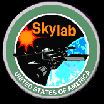|
| Mercury | Gemini | Apollo |

Skylab, America's first space station, was launched on
May 14, 1973. Almost immediately after it reached orbit
NASA discovered technical problems caused by the launch. A
critical meteoroid shield ripped off taking one of the
craft's two solar panels with it; a piece of the shield
wrapped around the other panel keeping it from deploying.
The first manned mission, commanded by Charles Conrad, became
a repair mission that involved a spacewalk to free a solar
panel and deploy a parasol sunshade.
Successful in all respects, despite the early mechanical
difficulties, the station was occupied by three crews for
a total of 171 days, 13 hours. It was the site of nearly 300
scientific and technical experiments.
The empty Skylab spacecraft returned to Earth July 11, 1979
scattering debris over the Indian Ocean and the sparsely
settled region of Western Australia.
Main Objectives
- To prove that humans could live and work in space for extended periods
- Expand our knowledge of solar astronomy well beyond Earth-based observations
Unmanned Missions
- Skylab 1
May 14, 1973
Skylab station launched into orbit by a Saturn V rocket.
Manned Missions
- Skylab 2
May 25 - June 22, 1973
Charles "Pete" Conrad, Paul Weiz, Joseph Kerwin
- Skylab 3
July 28 - September 25, 1973
Alan Bean, Jack Lousma, Owen Garriott
- Skylab 4
November 16, 1973 - February 8, 1974
Gerald Carr, William Pogue, Edward Gibson
|

